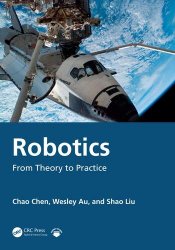Robotics: From Theory to Practice
- Добавил: literator
- Дата: 30-06-2025, 19:51
- Комментариев: 0
 Название: Robotics: From Theory to Practice
Название: Robotics: From Theory to PracticeАвтор: Chao Chen, Wesley Au, Shao Liu
Издательство: CRC Press
Год: 2025
Страниц: 459
Язык: английский
Формат: pdf (true), epub
Размер: 75.1 MB
Robotics: From Theory to Practice introduces robotic theories and technologies to audiences, including university students, professionals with engineering backgrounds, and even high-school students interested in building their own robots. We aim to bridge the gap between classic theories and real-world applications of robotic manipulators, which, to date, have far exceeded the domain of conventional industry.
The contents are divided into three parts. The first two cover classic theories of robotics, including kinematics, dynamics, path planning, control, and programming. Specifically, Part I is an introduction targeting junior students, featuring more simplistic topics and examples. Part II provides the senior students and professionals with more in-depth discussions on critical topics and more comprehensive examples. In Part III, we demonstrate how classic robotics theory can be extended to more advanced theoretical frameworks and adopted in real-world applications beyond conventional industries.
There are concepts and theorems in robotics that may be difficult to understand or visualise, particularly those involving three or more dimensions. Therefore, we have included comprehensive examples with MATLAB code, which can assist in the visualisation and understanding, and also be generalised for various robotic systems. We hope that this feature will make the fundamental mathematics and algorithms more interesting, insightful, and engaging for the readers.
In this chapter, we introduce programming methods to model, simulate, and control serial chain manipulators. Many development environments and programming languages are used in the industry, research, and broader hobby and enthusiast environments. However, in the context of introductory robotics, we will focus on software and programming languages that are already familiar to undergraduate students: MATLAB, C++, and Python. Furthermore, we introduce the Robot Operating System (ROS), which is a commonly used middleware for programming and controlling a physical robot.
Throughout this textbook, we used a variety of MATLAB functions and features to model various aspects of a serial robot. MATLAB provides the perfect environment for learning robotics, not only to model the kinematics and dynamics of a robot but also to provide visualisations using MATLAB's built-in graphical functions.
ROS is an open-source, meta-operating system for your robot. It provides the services you would expect from an operating system, including hardware abstraction, low-level device control, implementation of commonly used functionality, message-passing between processes, and package management. It also provides tools and libraries for obtaining, building, writing, and running code across multiple computers. More succinctly, ROS is known as a middleware, which serves to provide a standardised framework for the communications between hardware and software, to promote collaboration, expansion, and robust debugging through distributed computing, and to encourage code sharing through package management.
This textbook is valuable to broad readers, including those who have limited background in general engineering and wish to explore non-conventional applications of robotic manipulators. The scaffolded contents from Part I to Part III are created to lower the prerequisites and smooth the learning curve.
Скачать Robotics: From Theory to Practice
[related-news] [/related-news]
Внимание
Уважаемый посетитель, Вы зашли на сайт как незарегистрированный пользователь.
Мы рекомендуем Вам зарегистрироваться либо войти на сайт под своим именем.
Уважаемый посетитель, Вы зашли на сайт как незарегистрированный пользователь.
Мы рекомендуем Вам зарегистрироваться либо войти на сайт под своим именем.
